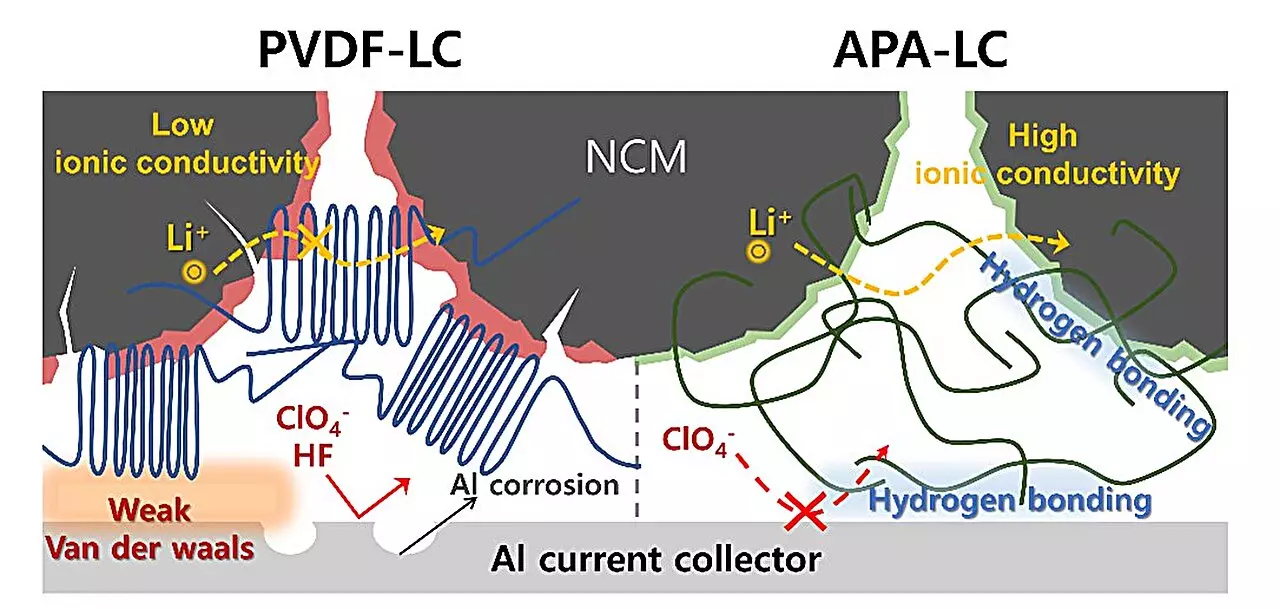As our world faces an escalating energy crisis compounded by environmental degradation, developing sustainable energy technologies has become paramount. Among these technologies, battery systems play a crucial role, powering everything from portable devices to electric vehicles. Yet, as the demand for cleaner energy storage grows, traditional battery technologies such as lithium-ion batteries have begun to show their environmental drawbacks. Recently, innovative research from POSTECH and Hansol Chemical has introduced a new class of battery materials designed to replace harmful, fluorinated components, thus positioning itself as a potential game-changer in the industry.
Conventional lithium batteries predominantly utilize fluorinated compounds, including polyvinylidene fluoride (PVDF) as a binder and lithium hexafluorophosphate (LiPF6) as an electrolyte. These chemicals, while effective for achieving desired battery performance, have significant downsides. The PVDF-LiPF6 system generates hazardous byproducts, notably hydrogen fluoride (HF), when exposed to elevated temperatures or during extended usage, profoundly impacting not only the battery’s lifespan but also posing environmental hazards. Additionally, the non-biodegradable nature of PVDF raises concerns about waste management and ecological sustainability, particularly in light of stringent regulatory frameworks in areas such as the European Union, which is moving towards banning per- and polyfluoroalkyl substances (PFAS) by 2026.
To counteract these pressing issues, the research team from POSTECH and Hansol Chemical has meticulously crafted an eco-friendly alternative battery system void of fluorinated compounds. Their new “APA-LC” system incorporates lithium perchlorate (LiClO4) as an electrolyte, effectively replacing fluorinated alternatives, and utilizes an aromatic polyamide (APA) binder that strengthens the connection between active cathode materials and current collectors. This innovation not only complies with impending regulatory measures but also enhances the overall performance and longevity of the battery.
The newly developed APA binder offers several advantages over traditional materials. It significantly reduces electrode corrosion, enabling improved bonding properties that enhance overall battery efficiency. Conversely, the LiClO4 electrolyte has been optimally engineered to facilitate faster lithium ion migration, ultimately contributing to superior energy output and shorter charging times.
The results from testing the APA-LC system have been promising, showcasing enhanced performance metrics compared to conventional systems. Notably, in controlled coin cell tests, the APA-LC setup demonstrated 20% better capacity retention after 200 cycles at a rapid charge/discharge rate of 1 C across a voltage range of 2.8 to 4.3 V. These findings suggest that not only does the new system provide a viable alternative to fluorinated solutions but also enhances performance characteristics that could drive consumer adoption.
Furthermore, the research team has successfully created a high-capacity 1.5 Ah pouch cell utilizing their new materials. This pouch cell displayed excellent discharge capabilities and strong performance during rapid charging experiments, underscoring the potential for mass-producing high-performance, environmentally friendly batteries.
Future Prospects and Industry Impact
The implications of this research extend beyond immediate performance benefits; they also present exciting opportunities for sustainable development in the battery industry. Professor Soojin Park of POSTECH asserts that the study represents more than simply a material replacement; it is a leap toward creating an industry grounded in sustainability. Young-Ho Yoon, Managing Director of Hansol Chemical, recognizes that by addressing the regulatory challenges posed by PFAS, they are not just innovating but also strategically positioning themselves in a rapidly evolving market projected to exceed KRW 1.7 trillion by 2026.
As the world shifts toward eco-friendliness, the demand for sustainable battery technology is poised to surge. The ongoing advancements by the POSTECH and Hansol Chemical teams serve as a beacon of hope, guiding the energy storage sector toward a greener future that prioritizes safety, performance, and sustainability without sacrificing efficiency. In this context, the development of non-fluorinated battery systems marks an essential step in paving the way for cleaner energy solutions, contributing to both immediate performance enhancements and long-term environmental responsibility.



Leave a Reply